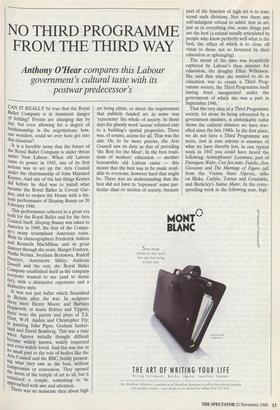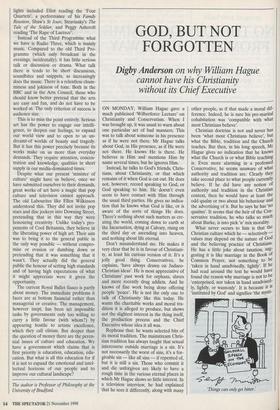NO THIRD PROGRAMME FROM THE THIRD WAY
Anthony O'Hear compares this Labour
government's cultural taste with its postwar predecessor's
CAN IT REALLY be true that the Royal Ballet Company is in imminent danger of folding? Events are changing day by day, but even allowing for a degree of brinkmanship in the negotiations, how, one wonders, could we ever have got into this situation?
It is a horrible irony that the future of the Royal Ballet Company is under threat under New Labour. When old Labour came to power in 1945, one of its first actions was to set up the Arts Council under the chairmanship of John Maynard Keynes. And one of the last things Keynes did before he died was to install what became the Royal Ballet in Covent Gar- den, and to reopen the House with a his- toric performance of Sleeping Beauty on 20 February 1946. This performance ushered in a great era both for the Royal Ballet and for the Arts Council itself. Sleeping Beauty was taken to America in 1949, the first of the Compa- ny's many triumphant American tours. With its choreographers Frederick Ashton and Kenneth MacMillan, and its great dancers through the years, Margot Fonteyn, Nadia Nerina, Svetlana Beriosova, Rudolf Nureyev, Antoinette Sibley, Anthony Dowell and the rest, the Royal Ballet Company established itself as the company everyone wanted to see (and to dance for), with a distinctive repertoire and a distinctive style. It was not just ballet which flourished ill Britain after the war. In sculpture there were Henry Moore and Barbara RePworth; in music Britten and Tippett; here were the poetry and plays of T.S. E. hot, W.H. Auden and Christopher Fry; ;II painting John Piper, Graham Suther- land and David Bomberg. This was a time when figures initially thought difficult became widely known, widely respected and even widely loved. And this was due in no small part to the role of bodies like the Arts Council and the BBC, boldly present- ing what they saw as the best, without compromise or concession. They opened the doors of the temple of art to all, but it remained a temple, something to be approached with awe and attention. There was no nonsense then about high art being elitist, or about the requirement that publicly funded art in some way `represents' the whole of society. In those days the ghastly word 'access' referred only to a building's spatial properties. There was, of course, access for all. That was the aim. Or, to be more precise, the Arts Council saw its duty as that of providing `the Best for the Most'. In the best tradi- tions of workers' education — another honourable old Labour cause — this meant that the best was to be made avail- able to everyone, however hard that might be. There was an understanding that the best did not have to 'represent' some par- ticular class or section of society, because part of the function of high art is to tran- scend such divisions. Nor was there any self-indulgent refusal to admit that in art, just as in everything else, some things just are the best (a refusal usually articulated by people who know perfectly well what is the best, the effect of which is to close off vistas to those not so favoured by their education or upbringing).
The mood of the time was beautifully captured by Labour's then minister for education, the doughty Ellen Wilkinson. She said that what she wanted to do in education was to create a Third Prog- ramme society, the Third Programme itself having been inaugurated under the government of which she was a part in September 1946.
That the very idea of a Third Programme society, let alone its being advocated by a government minister, is unthinkable today shows the cultural distance we have trav- elled since the late 1940s. In the first place, we do not have a Third Programme any more. Just in case anyone is unaware of what we have thereby lost, in one typical week in 1947 you could have heard the following: Aristophanes' Lysistrata, part of Finnegans Wake, Cosi fan tutte, Fidelio, Don Giovanni and The Maniage of Figaro (all from the Vienna State Opera), talks on Blake, Carlyle, Turner and Constable, and Berkeley's Stabat Mater. In the corre- sponding week in the following year, high- lights included Eliot reading the 'Four Quartets', a performance of his Family Reunion, Shaw's St Joan, Stravinsky's The Tale of the Soldier, and Peggy Ashcroft reading 'The Rape of Lucrece'.
Instead of the Third Programme what we have is Radio Three, which is mainly music. Compared to the old Third Pro- gramme (which only broadcast in the evenings, incidentally), it has little serious talk or discussion or drama. What talk there is tends to be short discussions, soundbites and snippets, as increasingly does the music. There is a relentless chum- miness and jokiness of tone. Both in the BBC and in the Arts Council, those who should know better pretend that the arts are easy and fun, and do not have to be worked at. The only criterion of success is audience size.
This is to miss the point entirely. Serious art has the power to engage our intelli- gence, to deepen our feelings, to expand our world view and to open to us un- dreamt-of worlds of beauty and tragedy. But it has this power precisely because its works make on us more than everyday demands. They require attention, concen- tration and knowledge, qualities in short supply in our media-dominated times.
Despite what our present 'minister of culture' might have us believe, once we have submitted ourselves to their demands, great works of art have a magic that pop culture and television cannot approach. The old Labourites like Ellen Wilkinson understood this. They did not invite pop stars and disc jockeys into Downing Street, pretending that in this way they were honouring creativity. Unlike today's pro- ponents of Cool Britannia, they believe in the liberating power of high art. Their aim was to bring it to the general public in the only way possible — without compro- mise or evasion or dumbing down or pretending that it was something that it wasn't. They actually did the general public the honour of setting high standards and of having high expectations of what it might appreciate were it given the opportunity.
The current Royal Ballet fiasco is partly about money. The immediate problems it faces are at bottom financial rather than managerial or creative. The management, however inept, has been set impossible tasks by governments only too willing to curry a little favour (with whom?) by appearing hostile to artistic excellence, which they call elitism. But deeper than the question of money there are the peren- nial issues of culture and education. We have a government which claims that is first priority is education, education, edu- cation. But what is all this education for if it is not to expand the emotional and intel- lectual horizons of our people and to improve our cultural landscape?
The author is Professor of Philosophy at the University of Bradford.



















































































 Previous page
Previous page